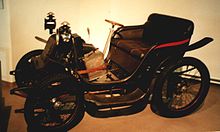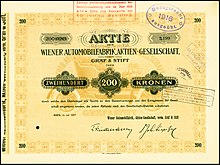Graf & Stift
| Graf & Stift
|
|
|---|---|
| legal form | Corporation |
| founding | 1904 |
| resolution | 1971 |
| Reason for dissolution | Merger with ÖAF and subsequent takeover by MAN |
| Seat | Vienna , Austria |
| Number of employees |
|
| Branch | Motor vehicle manufacturer |
Gräf & Stift (from 1907: Wiener Automobilfabrik AG, formerly Gräf & Stift ) was a 1904 by the brothers Franz (1874-1940), Heinrich (1877-1943) and Carl Graef (1871-1939) and the businessman and investor Wilhelm Pen sen. (1845–1917) founded Austrian automobile manufacturer .
Company history
In 1896 the three Gräf brothers founded a workshop in Vienna, which in 1897 delivered the first car with a water-cooled four-cylinder engine. This vehicle was equipped with a four-speed gear transmission with gate shift instead of the belt transmission that was common at the time. 1898, the first was automobile with front-wheel drive produced. They patented this technique in 1900 .
In 1901 the investor Wilhelm Stift sen. who founded the public company Gräf & Stift (mechanics) with the Gräf brothers on November 1, 1901 , which from 1904 ran the company at Weinberggasse 70, Vienna- Döbling ( Sievering district ). From 1905 the company mainly built large limousines (e.g. for the Habsburg imperial family) and small buses, which from 1908 a. a. were used for tourist traffic. In addition, Gräf & Stift was also an important manufacturer in Austria of buses - both for urban and intercity transport - and of superstructures for trams. The Dolomitenbus developed by Gräf & Stift had 22 kW (30 HP), a folding top and eleven seats, which were divided into two classes. It was used on the Vienna – Bolzano route.
The company's vehicles had a statue of a lion as a hood ornament , the shape of which was modeled on the lion by the sculptor Rudolf Weyr at the Nussdorf lock in Vienna.


In a Doppelphaeton (28/32 PS) by Graf & Stift, which is owned by Franz Count Harrach was the Austro-Hungarian heir to the throne sat Franz Ferdinand and his wife, Duchess Sophie von Hohenberg , as on 28 June 1914 at her in Sarajevo , the Assassination attempt that sparked the First World War was committed. The car is exhibited today in the Army History Museum in Vienna.
During the war years of 1916/17, the Döblingen plant was significantly expanded. The planning was in the hands of architect Philipp Jakob Manz .
In 1929, Gräf & Stift merged with the Perl automobile factory , which had been based in what is now the Vienna district of Liesing since 1922 . At first, trucks and buses were primarily produced there, but production was temporarily stopped in 1929.
On May 28, 1931, the long-distance line Vienna – Budapest was opened with Graef & Stift buses. The first trip was made in six hours by the bus designer, Dipl.-Ing. Josef Gräf, carried out himself.
In March 1938 the workforce only consisted of around 300 men, some of whom were on short-time work. After the "Anschluss" , 1,500 people were employed. The production program was switched from small series to large series of trucks and buses.
After the Second World War, car production was not resumed. In the early 1960s, the company began to make losses. In 1964 only 165 trucks were built. Around 1970 the losses continued to increase. Gräf & Stift started negotiations with the Österreichische Automobil Fabriks-AG and in 1971 the ÖAF acquired 99% of the Gräf shares. The new company name was now ÖAF-Gräf & Stift AG . In the same year the company was taken over by MAN AG. As a result, in-house designs were abandoned in favor of slightly modified MAN trucks and buses.
In 1978 the company received the state award and was allowed to use the federal coat of arms in business transactions.
In 1988 MAN built a new plant on the site of the old Gräf & Stift plant in Liesing.
In 2004, MAN again invested seven million euros in a modern, environmentally friendly paint shop, thereby safeguarding jobs in Vienna. MAN at the old Gräf & Stift site is still the largest employer in the district.
Since 1988 the Gräfweg in Vienna-Döbling ( 19th district of Vienna ) has been commemorating the founders of the company.
vehicles
Cars 1920–1938
| Type | Construction period | cylinder | Displacement | power | Vmax |
|---|---|---|---|---|---|
| VK 1 | 1920-1925 | 4 row | 1877 cm³ | 20 hp (14.7 kW) | 80 km / h |
| SR 2 | 1921-1924 | 6 row | 7749 cc | 75 hp (55 kW) | |
| SR 3 | 1924-1926 | 6 row | 7749 cc | 90 hp (66 kW) | |
| SP 5 | 1924-1933 | 6 row. | 3920 cc | 70 hp (51 kW) | 100 km / h |
| S 3 | 1925-1931 | 6 row | 5959 cm³ | 80 hp (59 kW) | 120 km / h |
| SR 4 | 1926-1928 | 6 row | 7749 cc | 110 hp (81 kW) | 110 km / h |
| VK 2 | 1926-1930 | 4 row | 1950 cc | 30 HP (22 kW) | 90 km / h |
| SP 7 | 1927-1929 | 6 row | 7070 cc | 120 hp (88 kW) | 125 km / h |
| SP 8 | 1930-1936 | 8 row | 5923 cc | 125 PS (92 kW) | 120 km / h |
| SP 6 | 1934-1935 | 6 row | 3920 cc | 85 PS (62.5 kW) | 110 km / h |
| MF 6 (= Citroën Rosalie) | 1934-1936 | 6 row | 2650 cc | 56 PS (41.2 kW) | 100 km / h |
| G 35 / G 36 / G 8 | 1935-1938 | 8 row | 4587 cc | 110 hp (81 kW) | 130 km / h |
| Graf-Ford V8 | 1936-1937 | 8 V | 3620 cc | 90 hp (66 kW) | 130 km / h |
| SP 9 | 1937-1938 | 8 row | 5923 cc | 125 PS (92 kW) | 130 km / h |
| C 12 | 1938 | 12 V | 4036 cc | 110 hp (81 kW) | 125 km / h |
Omnibuses
One of the buses manufactured by Gräf & Stift was the type DD-U 10. It was a three-axle double-decker bus for 105 passengers (66 of whom were seats) produced from 1960. The basis for the vehicle was the city bus TS-U 10. The 150 hp engine mostly came from Büssing . A little later there was also an articulated omnibus, both as a diesel or trolleybus train.
Trolleybuses
ÖAF Gräf & Stift also built electric trolleybuses for the cities of Salzburg , Linz, Innsbruck (Austria), Solingen , Eberswalde (Germany) and Bergen (Norway) as well as a duo bus prototype for Essen . Some of the vehicles for the companies in Germany were delivered under the brand name of the parent company MAN, but were recognizable as being built in Liesing by the factory identification in the chassis number.
truck
The Graef & Stift ZAFD was a tractor of the Austrian Armed Forces. But there were also 4x4 and 6x6 trucks with a single cabin and with a double cabin from this company. One of these heavy trucks was the three-axle type ZT 200. The ZVT-9F tractor unit was built around 1960, and these vehicles were also exported to the GDR . The L / LA 200 series stood out for its particularly high level of standardization. Starting from a basic type, vehicles with a payload of 5.3 to 18.5 tons were produced.
Special series
In addition to buses, Gräf & Stift also manufactured superstructures (car bodies) for tram chassis. Gräf & Stift produced mobile post offices , blood donation buses, X-ray buses, hospital buses for the armed forces , as well as apron buses 14 meters long and 3.5 meters wide for the airports in Vienna-Schwechat and Los Angeles ( USA ).
literature
- The war kitchen Gräf & Stift. In: Allgemeine Automobil-Zeitung. Allgemeine Flugmaschinen-Zeitung , No. 9, Volume I / 1917 (18th volume), March 4, 1917, p. 33 f. (Online at ANNO ). .
- Manfred Wehdorn, Ute Georgeacopol-Winischhofer, Paul Werner Roth: Architectural monuments of technology and industry in Austria. Volume 1: Vienna, Lower Austria, Burgenland . Böhlau, Vienna 1984, ISBN 3-205-07202-2 , p. 104 f . ( limited preview in Google Book search).
- Hans Seper : The Brothers Gräf, History of the Gräf & Stift automobiles. Österreichische Automobilfabrik ÖAF-Gräf & Stift Aktiengesellschaft Wien (Ed.), Welsermühl, Wels / Munich / Kreuzlingen 1991, ISBN 3-85339-216-4 .
- Hans Seper: From Austro-Fiat to the Austrian automobile factory ÖAF-Gräf & Stift AG, career - people - motor vehicles. Welsermühl, Wels 1994, ISBN 3-85339-206-7 .
- Gerhard Bruner (Ed.): Stefan Reitgruber: 100 years of vehicle construction in Vienna. Austro Fiat, Gräf & Stift, ÖAF, Perl. Association for the promotion of historic vehicles of the Austrian automobile factory ÖAF - Gräf & Stift AG, Vienna 2001, ISBN 3-9500535-5-7 .
- Karl-Hein Rauscher: From Fiat Vienna to MAN Nutzfahrzeuge Austria. Gnas, Weishaupt Verlag 2008, ISBN 978-3-7059-0282-4 .
- Christian Ortner , Thomas Ilming: The Sarajevo Car. The most historic oldtimer in the world , Verlag Edition Winkler-Hermaden, Vienna 2014, ISBN 978-3-9503611-4-8
Web links
- Entry on Gräf & Stift in the Austria Forum (in the AEIOU Austria Lexicon )
- Entry on Carl Gräf in the Austria Forum (in the AEIOU Austria Lexicon )
- ÖAMTC.at: ÖAF Gräf & Stift takes care of its history. ( Memento from November 12, 2005 in the Internet Archive )
Individual evidence
- ^ Wiener Automobilfabrik AG vorm. Graf & Stift. Friends of Historical Securities Auction Company, accessed August 28, 2012 .
- ^ Friedrich Ehn: A chrome jewel of a special kind. (No longer available online.) Federal Monuments Office , archived from the original on June 2, 2016 ; Retrieved August 28, 2012 . Info: The archive link was inserted automatically and has not yet been checked. Please check the original and archive link according to the instructions and then remove this notice.
- ↑ Seper: The Brothers Gräf .
- ↑ E (lisabeth) Lebensaft: Stift, Wilhelm d. Ä .. In: Österreichisches Biographisches Lexikon 1815–1950 (ÖBL). Volume 13, Verlag der Österreichischen Akademie der Wissenschaften, Vienna 2007–2010, ISBN 978-3-7001-6963-5 , p. 259.
- ↑ Lehmanns Allgemeine Wohnungs-Anzeiger (...) . Volume 1, evidence. Logged companies. Vienna 1905, p. 398, bottom right. - online .
- ↑ From Fiat Vienna to MAN Nutzfahrzeuge Austria ISBN 978-3-7059-0282-4
- ^ Thomas Hofmann: Vienna, the city of lions. In: Universum Magazin. December 2016, No. 12/2016. ZDB -ID 2092993-6 p. 79.
- ↑ Dr. J .: Börsen-Rundschau. (...) The company of Automobilfabrik A.-G. formerly Gräf & Stift (...). In: Monday newspaper. Imparteiische Zeitung , No. 1918/1917 (XLIV. Volume), February 12, 1917, p. 3, bottom center. (Online at ANNO ).
- ↑ Philipp Jakob Manz. In: Architects Lexicon Vienna 1770–1945. Published by the Architekturzentrum Wien . Vienna 2007.
- ↑ Gräf & Stift advertising brochure around 1939.
- ↑ Austrian double-decker bus . In: Motor vehicle technology 12/1960, pp. 492–494.
- ↑ Articulated bus with diesel or electric drive . In: Motor vehicle technology 8/1961, pp. 336–338.
- ↑ Heavy trucks from Austria. In: Motor vehicle technology , No. 10/1958, p. 379 ff.
- ↑ ZVT-9F tractor unit . In: Motor Vehicle Technology 3/1960, pp. 101-102.
- ↑ Heavy goods vehicles from standardized components . In: Motor vehicle technology 9/1960, pp. 364–365.








